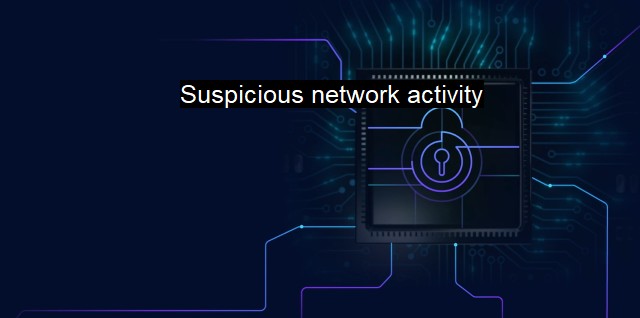What is Suspicious network activity?
Suspicious Network Activity: Keeping Your Business Safe from Cyber Threats through Detection and Response Mechanisms
Suspicious network activity refers to a class of activities or patterns on a computer network that suggest malicious intent or potential security threat. This could be an attempt to compromise the confidentiality, integrity, or availability of your digital data and resources. recognizing these actions and dealing with them appropriately is key to preventing or mitigating potential threats and maintaining the overall network security.Suspicious network activity essentially involves any action that deviates from the norm. Under typical circumstances, computers on a network communicate with each other or with external systems in predictable, protocol-conforming ways. cyber threats, often act in disparity, by either sending unusual traffic, interacting with systems in varying patterns, or accessing resources unpredictably. This deviation from regular network patterns and policy incites alarm and is then considered suspicious.
Various scenarios can define suspicious network activity. For instance, multiple failed login attempts, especially by the same user or from the same IP, often pinpoints towards an attempted unauthorized system access or a brute force attack by cyber-criminals. Cyber attackers also usually target specifically valued information like monetary transactions or database access. If systems involved in these transactions are noted to behave unusually, it's often due to suspicious network activity.
A sudden increase in network traffic without a clear source can signify a Distributed Denial of Service (DDoS) attack where multitudes of systems are used simultaneously to overwhelm and shut down targeted servers or networks. Unusual outbound network traffic could also indicate malware or a network attacker sending data, vulnerable information, or resources back to the cybercriminal’s system.
In retrospect, the usage of Ports is a typical method of communications over networks. Usually, specific protocol-conforming ports are utilized for various network activities. non-standard or unexpected ports might be a red flag for suspicious network activity, often hinting at cases where attackers attempt to bypass security by blending their traffic with legitimate network flows.
Detecting and thwarting suspicious network activity is possible using modern cybersecurity techniques and tools. Network Intrusion Detection Systems (NIDS) and Network Intrusion Prevention Systems (NIPS) inspect inbound and outbound network traffic for signs of suspicious activity by using network behavior analytics or signature-based detection. Similarly, Advanced Threat Detection platforms use artificial intelligence and machine learning to anticipate and recognize threats that traditional security approaches may miss.
Anti-Virus and Anti-Malware tools play a crucial role, wherein they monitor applications and file behavior for recognizing suspicious undertones and preventing malicious software from delivering their harmful payload. Firewalls also provide effective defense against suspicious network activities by blocking unwanted network communication based on rules or secure policies.
While software and automated approaches are necessary in detecting and preventing cyber threats, human factor also contributes significantly towards safeguarding the organization. Regular network audits and regularly educating staff on recognizing potential cyber threats, helps to identify cases of internal network misuse, social engineering attempts, or phishing, which tend to often fly beneath the radar of automated systems.
Suspicious network activity forms the initial layer of signs that indicate potential cyber threats. They mark anomalous behavior and deviances from the normative network patterns, pointing towards attempted or ongoing cyber attacks that can have a severe impact on such as data loss, breaches of privacy, or unscheduled downtime. Therefore, continuous monitoring, recognition, and appropriate actions against such activities are indispensable in maintaining network security.

Suspicious network activity FAQs
What is suspicious network activity in the context of cybersecurity and antivirus?
Suspicious network activity refers to any unusual or unauthorized network activity that is detected by an antivirus or security software. This can include network traffic that is not typical for a given system or user, attempts to access restricted resources, and other anomalous network activity that may indicate a security breach.How can I identify suspicious network activity on my network?
To identify suspicious network activity, it is necessary to monitor network traffic and look for patterns or anomalies that may indicate a security threat. This may include unusual port activity, excessive bandwidth usage, and other signs of potential compromise. Antivirus and security software can also be used to detect and alert users to suspicious network activity.What are some common causes of suspicious network activity?
Suspicious network activity can be caused by a variety of factors, including malware infections, unauthorized access attempts, network breaches, phishing attacks, and other forms of cybercrime. Poor security practices, such as weak passwords or lack of encryption, can also contribute to the risk of suspicious network activity.What should I do if suspicious network activity is detected on my network?
If suspicious network activity is detected on your network, it is important to take action immediately to mitigate the risk of a security breach. This may include blocking suspicious IP addresses, isolating infected systems, and updating security software to protect against known vulnerabilities. It is also important to investigate the source of the suspicious network activity and take steps to prevent future attacks. In some cases, it may be necessary to contact a cybersecurity professional for assistance.| | A | | | B | | | C | | | D | | | E | | | F | | | G | | | H | | | I | | | J | | | K | | | L | | | M | |
| | N | | | O | | | P | | | Q | | | R | | | S | | | T | | | U | | | V | | | W | | | X | | | Y | | | Z | |
| | 1 | | | 2 | | | 3 | | | 4 | | | 7 | | | 8 | | |||||||